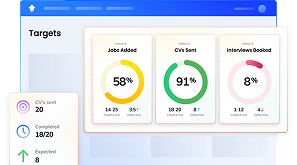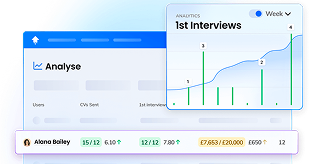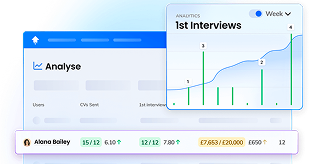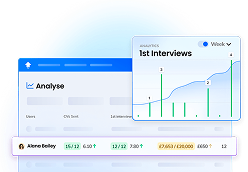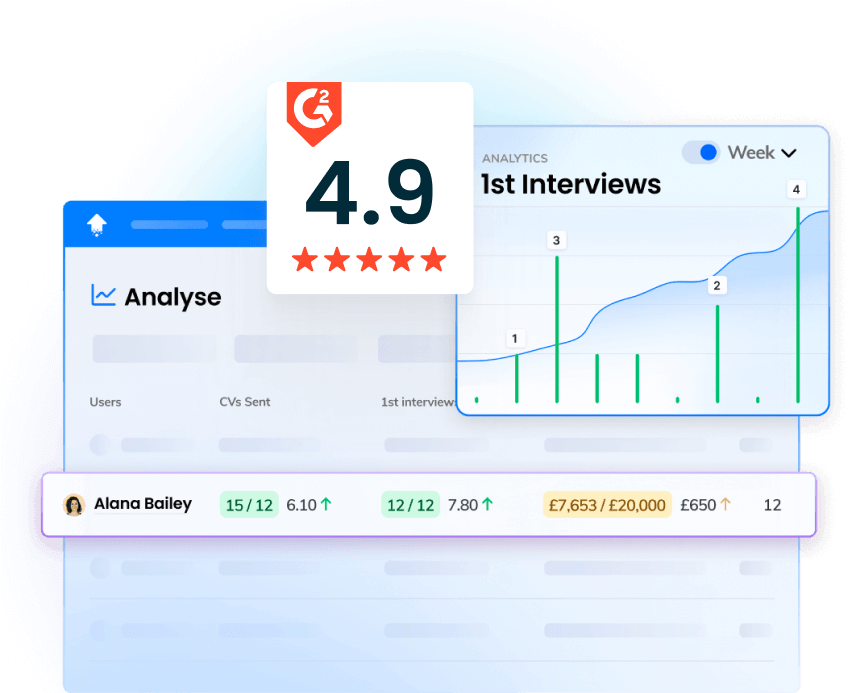Sales efficiency is critical in 2024's highly competitive, fast-paced sales landscape.
With many organisations slashing budgets, it has never been more important to maximise resources and ensure sustainable sales processes.
In this guide, we'll outline an actionable 17-step plan for improving your sales efficiency, explain how to measure it and reveal what your ratio means.
What is Sales Efficiency?
In simple terms, sales efficiency is a measure of how well your company generates revenue through sales activity.
It tells you how much revenue you bring in against your sales and marketing spend.
And the more revenue you generate from a limited sales and marketing budget, the higher your sales efficiency.
Ultimately, sales efficiency is a helpful indicator of how well your current sales strategy is working and whether it needs to be adjusted.
There are two different ways to calculate sales efficiency: gross sales efficiency and net sales efficiency.
The gross sales efficiency measurement looks solely at annual recurring revenue generated over the previous period.
It does not take into account any down-selling or churn.
This gives you a clear picture of how your sales and marketing activities are performing, unimpeded by any adjustments.
Net sales efficiency, on the other hand, does account for lost business as well as new sales.
It's helpful to track both of these sales efficiency metrics and compare the results. If your net sales efficiency is significantly higher than your gross sales efficiency, it could be time to focus on retention.
Sales Efficiency vs. Sales Effectiveness vs. Sales Productivity
Sales efficiency, effectiveness, and productivity are often used interchangeably — but they all mean slightly different things.
- Sales efficiency tells you how much revenue you generate for every pound spent on sales and marketing. It focuses on the best resource allocation and helps you determine how to assign those resources to achieve the best results.
- Sales effectiveness is about how you use those resources. To achieve effectiveness of sales, your team needs to be highly productive, skilled in their role, and hitting their goals quickly.
- Sales productivity is an indicator of sales team output. It is measured through sales efficiency and effectiveness — productivity will increase if you improve those two metrics. Improving productivity tends to be the goal of any sales improvement effort.
Each of these metrics plays an essential role in a successful sales strategy.
Sales efficiency tells you how best to allocate your resources, sales effectiveness indicates how to use them for the best results, and sales productivity reveals the outcome.
Why Sales Efficiency Is Important in 2024
Sales efficiency has always been important: it gives leaders important insights into the health of their sales processes and directly correlates with your company's revenue.
But in the highly challenging sales landscape of 2024, achieving a high level of sales efficiency is paramount.
Many sales budgets have been slashed, and leaders must find a way to achieve the same goals with fewer resources.
This means that companies that don't continuously strive to achieve sales efficiency are simply no longer sustainable.
It's more important than ever that sales leaders and managers take more control of their team's direction and performance, using advanced data analytics tools to glean key insights and adjusting and improving as needed.
After all, those who run their sales teams efficiently will gain a significant competitive advantage.
How to Measure Sales Efficiency
Wondering how to calculate sales efficiency?
The calculation for gross sales efficiency looks like this:
Gross Sales Efficiency = Gross New Annual Recurring Revenue / Sales and Marketing Expense
To work out your net sales efficiency, perform the following sales efficiency calculation:
Net Sales Efficiency = Net New Annual Recurring Revenue / Sales and Marketing Expense
There are a number of other sales metrics and KPIs that will help you drill down into your sales efficiency results to determine which elements of your sales and marketing efforts are working and which need to be adapted.
To gain more insight into sales efficiency at your organisation, consider tracking the following sales metrics:
- Revenue growth
- Customer Acquisition Cost
- Win rate
- Quota attainment
- Conversion rate
- Sales cycle length
- Average deal size
- Client retention rate
- Sales productivity metrics such as BD calls made, emails sent, etc
The Sales Efficiency Ratio
When you complete the sales efficiency formula, you'll be left with a low number — this is your sales efficiency ratio.
The higher your sales and marketing efficiency ratio, the better.
Indeed, if your score is over three, you can rest assured that your sales efficiency is exceptionally high.
A score between one and three means your sales team is generating positive ROI, but your sales efficiency could be improved.
If your sales efficiency ratio is around one, you're breaking even, and if it is under one, you're spending more on the sales process than you're generating in revenue.
This tells you that swift action is needed to determine what is going wrong in your sales processes and rectify these issues.
Step-by-Step Guide on How to Improve Sales Efficiency
Every single sales team out there would benefit from a sales efficiency boost.
Read on for our 17-step guide on how to improve sales efficiency.
#1 Assess Your Current Sales Process
Start your sales efficiency drive by auditing your current process.
Follow the journey a sales rep in your team takes from the start of the selling process to the end.
Are there any obvious efficiency gains you could make?
For example, if you notice that tedious, repetitive tasks are taking up a lot of time, you could invest in an automation tool to take this work off your team's hands.
Next, conduct a one-to-one meeting with each sales rep to find out how they feel about the sales process — after all, they're the ones who know it best.
They may have insightful suggestions for making the process more efficient, such as reducing the amount of red tape they have to wade through to make a sale.
Finally, dive into your data to identify bottlenecks and inefficiencies in your systems.
Are customers being held up at a particular stage of the sales cycle? Is one stage taking way longer than it should?
Investigate the activities behind any issues you notice in the data, and then take swift action to solve these problems and drive up your sales efficiency.
#2 Set Clearly Defined SMART Goals
When it comes to how to track sales performance, this is essential.
To achieve sales efficiency, your team must move in the same direction — towards their goals.
Indeed, setting realistic, achievable sales goals can instil a fresh sense of purpose in a team, driving up sales efficiency.
To be effective, your goals must align with the organisation's broader goals.
They must also be SMART:
- Specific
- Measurable
- Achievable
- Relevant
- Time-bound
These goals must be clearly communicated, and progress should be tracked on intuitive custom dashboards that reps can access at any time.

You may set team goals as well as individual objectives and use goal setting to help reps overcome weaknesses and develop professionally.
#3 Revisit Buyer Personas and Ideal Customer Profiles (ICPs)
When was the last time you reviewed your buyer personas or ideal customer profiles?
The market moves quickly, and sales teams need to adapt to ensure their sales reps are targeting the most relevant and promising prospects and leads.
After all, going after potential customers who are unlikely to buy is a sure way to dampen sales productivity.
A useful technique here is to segment your customer data to match your buyer personas and ideal customer profiles to discover what proportion of revenue accounts for that type of client.
Can you spot trends among your customer base that could be useful when refreshing your buyer personas and ideal customer profiles?
For example, if your ideal customer profile is a CEO, but your data reveals that CTOs buy from you much more frequently, you'll need to change the job titles you're targeting.
Perhaps your buyer personas are all based in your city, but in fact, sales are spread out across the whole county. In this case, you'd want to widen the geographical remit of your ideal customer profile.
Figure out the group that is currently most likely to buy your product and/or service, and use this data to build your ideal customer profile.
Ensure you communicate this change clearly to your sales team, alongside ideas on how to tap into this market so that your sales activities target those most likely to buy.
And don't forget to frequently refresh these buyer personas and ideal customer profiles when the data changes.
#4 Accelerate Sales Training
The importance of training for sales efficiency success cannot be understated.
What skills and knowledge do you need your team to acquire to become a more efficient operation?
And are your current training methods working effectively to upskill your team?
As a busy sales leader, it's easy to be reactive when it comes to training.
If we invest in new software or launch a new product, we'll of course ensure our sales team is trained on it.
But to increase sales efficiency, it's crucial to be more thoughtful about training and to speed up the pace of progress.
Consider:
- Which learning and development activities need to happen for your team to pick up the skills and knowledge you want and need them to have?
- Which training formats will be most effective for each topic?
- In what order should these activities take place?
- Would certain sales reps benefit from specific training to help them overcome weaknesses?
- Can you or other internal staff members run the sessions, or would your team benefit from external trainers?
- How will you run your learning and development plan for new hires?
Put together a streamlined sales training plan that answers all the questions above and lays out how and when you intend to reach the point where your team has acquired the necessary skills and knowledge.
#5 Implement a Repeatable Sales Process
When it comes to sales efficiency, standardisation is king.
This makes it easier for reps to speed up their workflow and for new hires to reach productivity faster.
Of course, there's always the danger of standardising an inefficient process and actually damaging sales efficiency.
Before implementing a repeatable sales process, you need to prove it works.
This will involve examining the data, speaking to your sales reps about the process in question, and tightening up any less-than-efficient components.
Once you're satisfied that the sales process is as efficient as possible, it's time to standardise it across your team.
#6 Conduct Active and Effective Sales Coaching
While training involves upskilling your whole team during designated learning time, sales coaching is about steering an individual rep in the right direction.
A good sales coach monitors an individual rep's performance to discover areas for improvement and reinforce positive behaviours.
They will provide sales reps with the tools and skills they need to build their confidence and succeed in their career.
Coaching can be a time-consuming activity — especially if you lead a large team — but it pays off in several ways, including sales efficiency.
This is why you should regularly coach sales reps to reinforce their skills, address challenges, and encourage continuous improvement.
#7 Leverage the Right Tools for Measuring Efficiency
In 2024, measurement no longer needs to be a time-consuming task that involves an unending roster of indecipherable spreadsheets.
Instead, sales leaders can utilise sophisticated technology to track performance and identify areas for enhancement.
Leverage the best sales productivity tools to measure sales efficiency, and you'll get more accurate results and more profound insights — all while saving time and boosting efficiency thanks to automation tools.
Set SMART goals surrounding efficiency metrics and track progress on custom dashboards with intuitive visualisations.
Monitor efficiency metrics, and when you spot a problem in the data, dig deeper to investigate the activities causing it.
Leveraging advanced tech for measuring efficiency directly helps you iron out inefficient creases in your processes, swiftly troubleshoot, and improve.
#8 Refine Sales Messaging
Developing your sales messaging is not a one-time activity.
Your sales messages should directly respond to the needs and challenges of your target audience.
Over time, your target audience may change due to shifts in your sector or new products and/or services your company has launched.
But even if the target audience stays the same, their requirements and challenges will inevitably change.
From world events affecting importing and changes in consumer confidence to economic shifts in the UK and new legislation affecting businesses — there's always a new challenge you need to help them overcome.
This is why sales teams must continuously update and adapt their messaging to resonate with their target audience.
Continuing to use out-of-date sales messaging will drive down sales efficiency as you're unlikely to generate as much revenue as you would with fresh, new messaging that is relevant to your audience right now.
#9 Standardise Sales Onboarding
Research from Gallup revealed that the cost of replacing an employee sits at one-half to two times the original employee's salary.
Much of this cost is attributed to the time it takes to train a new staff member and get them up to speed.
No sales rep is going to be able to hit the ground running on day one, but there are efficiency gains to be had when it comes to onboarding new hires.
Create a consistent onboarding experience to efficiently get new sales reps up to speed.
Perfect and streamline your onboarding process until it achieves the desired results in the shortest time possible.
While the best onboarding process for your organisation may involve input from yourself and colleagues, try to limit this to ensure you're not allocating unnecessary resources to getting new recruits up to speed.
Now, standardise this process, and remember to update it when necessary.
#10 Employ Sales Technology to Save Time
Modern sales technology is a monumental efficiency driver.
Integrate CRM systems designed to streamline your processes and centralise your data to enjoy huge time savings plus more in-depth data insights.
Many sales softwares include automation and generative AI, which can complete tasks such as writing and sending emails and guiding sellers to close.
Meanwhile, modern data analytics tools automatically pull data from across your tech stack, ensuring you have real-time reporting without any of the tedious data entry that was once required.
#11 Establish Routine Sales Activities
You don't want to micromanage — but too much freedom can knock your sales reps off track.
It's important to establish routine sales activities that must be completed every day, week, month, or quarter to ensure sales efficiency.
This could be as simple as setting a target such as 'make 20 BD calls every week' or 'respond to emails from leads in under 30 minutes during business hours'.
Or it may be a list of basic sales activities each sales rep needs to complete each day.
You must also hold your reps accountable for performing these activities by tracking their completion on custom dashboards.

This will keep your team active and ensure time isn't lost due to procrastination or dithering.
#12 Align Marketing and Sales Teams
Marketing and sales teams have the same purpose — to generate revenue for their organisation.
However, too often they are siloed and misaligned, representing a serious loss of efficiency.
So, how can you drive up sales and marketing efficiency?
Align your sales and marketing teams by setting shared goals clearly tracked on custom dashboards.
Open the lines of communication between the two departments by scheduling regular sessions to share feedback, strategies and insights, and investing in sales tools designed for collaboration.
It's also vital to ensure the branding and tone of voice used by sales reps in client meetings or sales enablement assets reflect marketing output.
If the sales experience doesn't truly reflect the company a prospect sees on your website, it will significantly dent their trust in your organisation.
#13 Solicit Feedback from Sales Reps
In the rush to harness the power of quantitative data, don't forget to harvest qualitative data, too.
In many cases, this simply means gathering feedback from your sales reps.
Your reps are the closest people to your sales processes and will likely have helpful, efficiency-related insights you won't know about unless you ask.
Set up regular group and individual feedback sessions to determine how your sales processes work from reps' perspectives.
Use these insights from those on the front line to inform process improvements and training needs.
#14 Nurture Leads Effectively
The loss of a promising lead significantly impacts a sales efficiency ratio.
Not only have you missed out on the income that would have been generated by that sale, but the resources dedicated to bringing in that lead have seen no ROI.
And more resources are going to need to be allocated to repeating the whole process from scratch to bring in another lead.
When sales reps are busy, lead nurturing can often slip to the bottom of their list of priorities — making leads much more likely to fall out of the sales cycle.
Therefore, it's crucial to develop a strategy for keeping leads engaged until they are ready to buy.
Useful lead nurturing tactics include:
- Targeted content
- Personalised email nurturing
- Sales calls
- Social media retargeting
- Dynamic website content
- Automated emails, texts, and notifications
Develop an omni-channel lead nurturing sequence across multiple touchpoints — and then standardise it.
This strategy should be automatically triggered whenever a new lead is qualified.
#15 Integrate Automation Approaches
Look out for sales tech that comes with built-in automation.

Automation takes care of tedious, manual tasks that were once part of sales reps' daily jobs.
Examples include lead nurturing sequences, responding to customer questions, scheduling meetings, sending personalised emails, and analysing data.
By automating these tasks, you're empowering sales reps to dedicate their time to high-value, human-led activities that directly contribute to bringing in revenue.
#16 Update the Sales Content Library Regularly
Every sales team has a large bank of content that supports the sales process.
But think about what's in your sales content library right now.
Does it include documents with outdated advice or information about old products or services that have since been stopped?
Perhaps some of the content features old branding or was written in a tone of voice that now feels old-fashioned.
While you might know which assets in your content library are still fit for use, newer team members may reasonably assume they can use any materials in the bank.
Presenting outdated documents to clients appears unprofessional, wastes their time, and is inefficient for your sales reps.
Ensure your sales content library is updated regularly, with fresh and relevant new content you're proud to showcase that is designed to engage your target audience.
#17 Monitor Sales Forecasting
Harnessing the power of modern sales forecasting tools can significantly drive up sales efficiency.
Regularly employ forecasting tech to accurately anticipate upcoming sales trends.
Now adjust your strategies accordingly and provide any extra training your sales team might need to wholly capitalise on these trends.
Utilising forecasting tools helps you allocate your resources in the right place at the right time, taking the guesswork out of your sales strategy and ensuring less time is wasted on projects that don't pay off.
Final Thoughts…
In the challenging sales landscape of 2024, driving up your sales efficiency helps to ensure your organisation is sustainable and competitive.
Start to improve your sales efficiency today by:
- Assessing your current sales process
- Setting clearly defined SMART goals
- Reviewing your buyer personas and/or ideal customer profiles
- Accelerating sales training
- Implementing a repeatable sales process
- Conducting active and effective sales coaching
- Leveraging the right tools for measuring efficiency
- Refining your sales messaging
- Standardising sales onboarding
- Employing sales technology to save time
- Establishing routine sales activities
- Aligning your marketing and sales teams
- Soliciting feedback from sales reps
- Nurturing leads effectively
- Integrating automation approaches
- Regularly updating your sales content library
- Monitoring sales forecasting
As outlined above, advanced tech tools provide a massive boost when it comes to sales efficiency.
Sales performance management software OneUp boasts a multitude of efficiency-boosting features that can support sales leaders and teams in implementing the strategies outlined above.
Advanced analytics tools such as custom dashboards and automated reporting empower leaders to roll out effective sales performance management strategies that boost efficiency.
Meanwhile, gamification features such as missions, leagues, and leaderboards ensure recruiters are motivated and engaged with these strategies.
To find out more about how OneUp can improve sales efficiency, book your demo here today.
